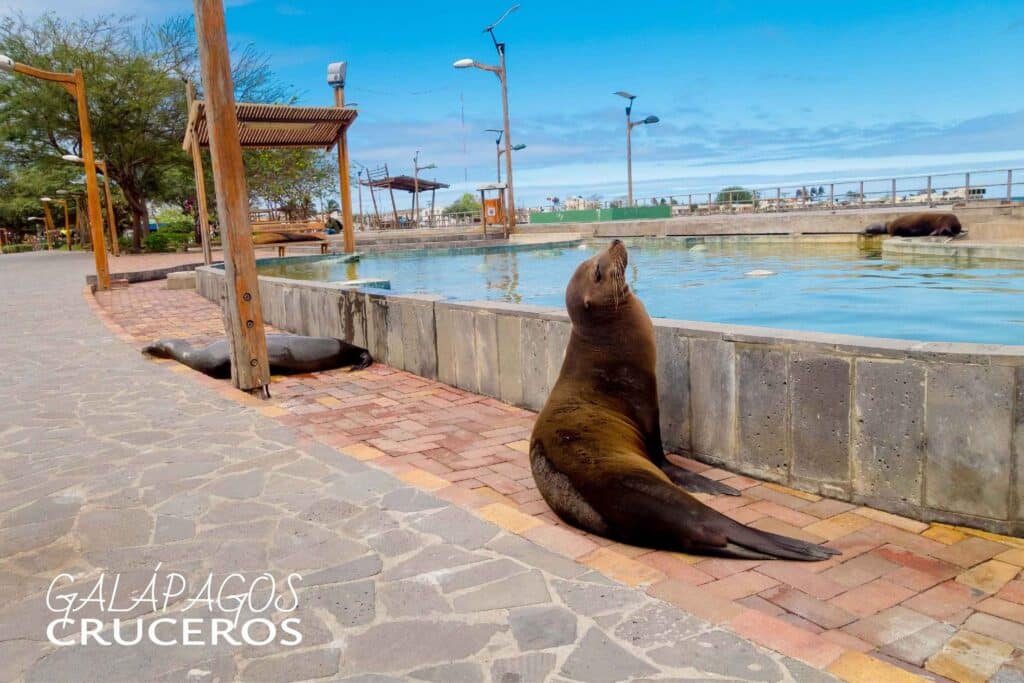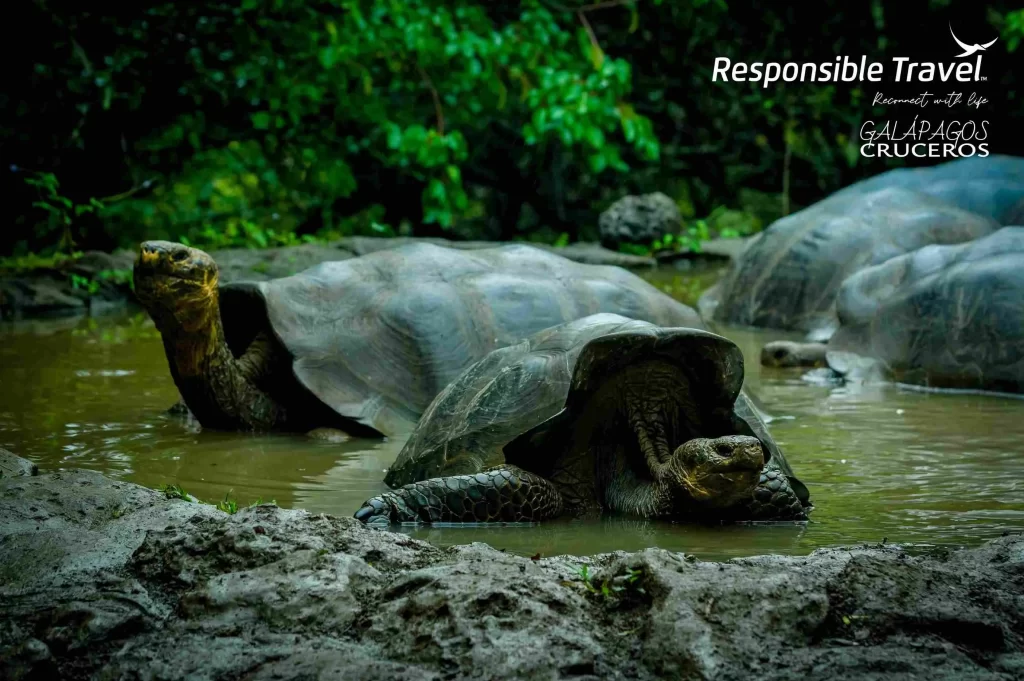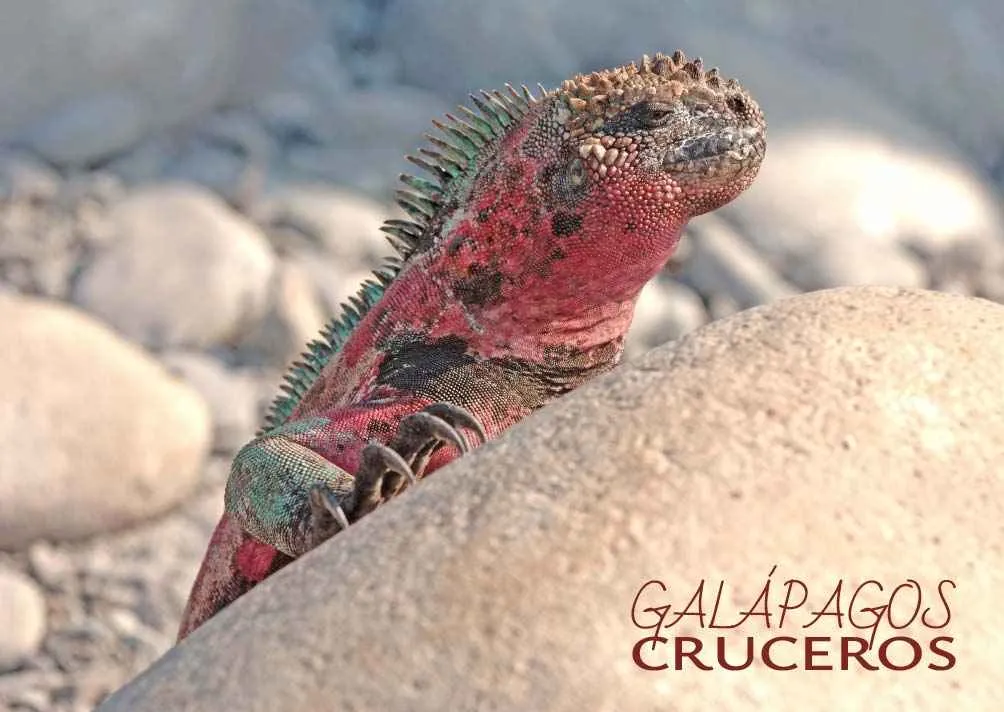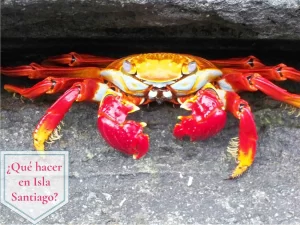-
Giant Tortoises
Icónicas habitantes del archipiélago y maravillas de la naturaleza. Su existencia se remonta a millones de años atrás y han capturado la imaginación amantes de la naturaleza.
-
Marine Iguanas
Tienen aspecto prehistórico y pueden sobrevivir tanto en tierra como en el agua, siendo un símbolo emblemático del archipiélago. Adaptadas al entorno volcánico y aguas cristalinas de Galápagos, son un ejemplo extraordinario de evolución.
-
Sea Lions
Los leones marinos de Galápagos son animales juguetones y ágiles, parte esencial del ecosistema marino. Su presencia encantadora y vitalidad en las aguas de las islas Galápagos es simplemente cautivadora.
-
Penguins
Los pingüinos de Galápagos son una especie rara y especial en el ecuador. Adaptados a las cálidas corrientes del archipiélago, estos pequeños nadadores son una muestra excepcional de la diversidad única de la vida en Galápagos.
-
Flightless Cormorant
El cormorán no volador de Galápagos es una joya única del archipiélago. Con sus alas atrofiadas y habilidades de natación excepcionales, este ave es un ejemplo fascinante de adaptación al entorno marino.
-
Frigate
La fragata de pecho rojo de Galápagos es una majestuosa ave marina. Con su envergadura imponente y su distintivo plumaje, domina los cielos y los mares del archipiélago.
The fauna of Galapagos has a very peculiar story that must be told. When the volcanoes When the first Galapagos islands began to form between three and five million years ago, they were isolated from life, separated by about a thousand kilometers from the mainland. Despite this, over time a good number of species have made the islands their new home, due to their ability to disperse, either actively or passively, and their ability to establish themselves after their arrival.

The Galapagos Islands are often called the 'laboratory of evolution' and are home to the unique wildlife of Galapagos. There are very few places in the world where such a great variety of species, both plant and animal, can be found in such a restricted area. Oceanic islands may host species that, although related to continental forms, have evolved differently from their relatives due to isolation in a new and different environment. This is the key factor in island evolution. The wildlife of Galapagos has evolved distinctly from its continental relatives. Charles Darwin was fascinated by the life on the islands and developed his theory of evolution thanks to this phenomenon.
Darwin's finches are a classic example of Galapagos wildlife and the phenomenon of adaptive radiation in birds, which has served generations of evolutionary biologists. The fauna of Galapagos has produced thirteen species that evolved within the archipelago from a common continental ancestor.
Types of Galapagos wildlife
Its unique wildlife, shaped by geographic isolation, includes iconic species such as giant tortoises, marine iguanas, sea lions, penguins, and endemic birds like the flightless cormorant. These animals offer visitors a unique wildlife observation experience, highlighting the extraordinary adaptation of species to the island environment. Here is a brief summary of the most important Galapagos fauna:
-
- Giant tortoises
-
- Marine Iguanas
-
- Sea lions
-
- Penguins
-
- Flightless cormorant
-
- Endemic birds (such as Darwin's finch)
Highlights of the Aspects of Nature
The word endemic refers to organisms that are not found anywhere else in the world because they evolved and remained isolated in a certain area and developed unique characteristics. Today you will find several species that fall under this classification in the Islands, the endemic plants and animals of Galapagos. Below you will find descriptions of some of the endemic animals of the Galapagos Islands:
Especies que habitan en Galápagos
The Galapagos land iguana (Conolophus subcristatus) is a species of lizard in the family Iguanidae and one of three species in the genus Conolophus. It is endemic to the Galapagos Islands, mainly the islands of Fernandina, Isabela,
Santa Cruz Island
, North Seymour
Española
and South Plaza.
The Galapagos land iguana varies in morphology and coloration among the different island populations. There are two taxonomically distinct forms of Conolophus inhabiting the western part of the islands (C. rosada and C. pallidus) and one in the central part (C. subcristatus).
The Galapagos land iguana grows to a length of three to five feet (approx. 90 cm - 120 cm) with a body weight of up to twenty-five pounds (approx. 12 kg), depending on the island they come from. Being cold-blooded, they absorb the sun's heat by basking on volcanic rocks and at night they sleep in burrows to conserve body heat. These iguanas also enjoy a symbiotic relationship with birds; the birds remove parasites and ticks, providing relief for the iguanas and food for the birds. The Galapagos land iguana is estimated to have a lifespan of 50 to 60 years.
Galapagos sea lion
The Galapagos sea lion (Arctocephalus galapagoensis) breeds in the Galapagos Islands in the eastern Pacific, west of mainland Ecuador, and is endemic to the islands. The sea lions live on the rocky shores of the islands, which tend to be on the western side of the islands, and haul out only to feed. These seals do not migrate and remain close to the islands for their entire lives, which average about 20 years. Galapagos fur seals feed mainly on fish and mollusks. They feed relatively close to shore and near the surface, but have been seen at depths of 169 meters. They feed mainly at night because it is much easier to catch their prey.
It appears that the Galapagos fur seal is no longer found only in the Galapagos Islands, but that a colony has moved to northern Peru, according to Orca, Organization for Research and Conservation of Aquatic Animals.

Galapagos Green Turtle
The Galapagos Green Turtle (Chelonia mydas agassisi) is a subspecies of the Green Turtle (Chelonia mydas). It is endemic to tropical and subtropical waters of the Pacific Ocean. They are often classified as an eastern Pacific population of green turtles. This title is shared with the other nesting populations of green sea turtles that inhabit the Pacific Ocean.
The Galapagos Green Turtle is the only population of Green Sea Turtles that nests on the beaches of the Galapagos Islands. It has been difficult for researchers to obtain valid information on the lifestyles of the Galapagos Green Sea Turtle due to its continuous migrations and submersion in the ocean; most information has been obtained through experimentation with tagging. The Galapagos Green Turtle, along with all other green sea turtle populations, is listed as endangered on the IUCN Red List of Threatened Species.
Galapagos giant tortoise
The Galapagos tortoise or giant Galapagos tortoise (Geochelone nigra) is the largest living tortoise, native to seven islands of the Galapagos archipelago. Adult individuals can weigh over 300 kilograms (661 pounds) and reach a length of 1.2 meters (4 feet). They are long-lived, with an estimated lifespan of 100 to 150 years in the wild. Populations have drastically declined since the 17th century due to hunting and the introduction of predators and herbivores by humans. Today, only ten of the original twelve subspecies remain in the wild. However, conservation efforts since the establishment of the Galapagos National Park and the Charles Darwin Foundation have been successful, with hundreds of captive-raised juveniles released onto their native islands. They have become emblematic of Galapagos wildlife.

The Lonesome George (Spanish: Solitario Jorge) is the last known individual of the Pinta Island tortoise (Geochelone nigra abingdoni), which is one of the subspecies of Galapagos tortoises. It has been labeled the rarest creature in the world and is a potent symbol of conservation efforts in the Galapagos and internationally.
George was first spotted on Pinta Island on December 1, 1971, by American biologist Joseph Vagvolgyi. The island's vegetation had been decimated by introduced feral goats and the native tortoise population had been reduced to a single individual. Relocated for his safety to the Charles Darwin Research Station, George was enclosed with two females of a different subspecies, but although eggs have been produced, so far none have hatched.
Galapagos marine iguana
The marine iguana (Amblyrhynchus cristatus) is an iguana found exclusively in the wildlife of the Galapagos Islands, possessing the unique ability among modern lizards to live and feed in the sea. It has spread across all islands of the archipelago and is sometimes called the Galapagos marine iguana. It primarily inhabits the rocky coast of Galapagos but can also be observed in swamps and mangrove beaches. Marine iguanas feed almost exclusively on sea algae, expelling excess salt through their nasal glands while basking in the sun. The salt layer can make their faces appear white.
In adult males, the coloration varies depending on the season. Adult males in breeding season on the southern islands are the most colorful and will take on reddish and bluish green colors, while on Santa Cruz they are brick red and black, and on Fernandina they are brick red and dull greenish.
Another difference between iguanas is size, which varies according to the island on which the individual iguana lives. Iguanas living on Fernandina and Isabela islands are the largest iguanas found in the Galapagos. On the other end of the spectrum, the smallest iguanas are found on the
Genovesa Island
.
Adult males are up to 1.7 m long, females between 0.6 and 1 m and males weigh up to 1.5 kg.
On land, the marine iguana is a rather clumsy animal, but in the water it is an elegant swimmer.

The reptile genus Tropidurus includes several species of terrestrial lizards. It includes seven that are endemic to the Galapagos Islands, where they are collectively known as lava lizards. The distribution of these lizards and their variations in shape, color, and behavior show the phenomenon of adaptive radiation so typical of the inhabitants of this archipelago. One species is found on all the central and western islands, which may have been connected during periods of lower sea levels. On six other, more peripheral islands, a single species is found on each island. Most likely they all evolved from a single ancestral species.
Males and females of all Tropidurus species are marked differently. The male is usually much larger than the female and its body has brighter colors and a distinctive pattern. The average size of lizards varies greatly from habitat to habitat, as does the pattern of body markings; animals living primarily in dark lava are darker than those living in lighter sandy environments. Markings vary considerably, even within species, and, like many lizards, show color changes with mood and temperature.
Flightless cormorant
The flightless cormorant (Phalacrocorax harrisi), also known as the Galapagos cormorant, is one of the most unusual species in the Galapagos fauna because it is the only cormorant in the world that cannot fly. This bird, endemic to the Galapagos Islands, illustrates how the wildlife of the Galapagos has evolved uniquely due to its remote geographical location. The flightless cormorant, with an estimated population of only 1,500 individuals, is among the rarest birds in the world. It is part of an active conservation program aimed at protecting this fascinating species and ensuring its survival in its natural habitat.
This unique cormorant is found on only two islands: Fernandina Island , where it is found mainly on the east coast, as well as on the north and west coasts of the Isabela Island . This species inhabits the rocky shores of the volcanic islands where it is found. It feeds in shallow coastal waters, including bays and straits, and rarely ventures more than one kilometer from breeding grounds.
Galapagos cormorants evolved in an island habitat free of predators. Having no enemies and obtaining its food mainly by diving along the food-rich coasts, the bird eventually stopped flying.
The flightless cormorant is the largest member of its family, 89 to 100 cm (35 to 40 inches) long and weighing 2.5 to 5.0 kg (5.5 to 11 pounds), and its wings are about one-third the size that would be needed for a bird of its proportions to fly. The keel of the sternum, where the birds attach the large muscles needed for flight, has also been considerably reduced.
Darwin's finch
Darwin's finches (also known as Galapagos finches or Geospizinae) are a group of 14 species of passerine birds (including one species from Cocos Island), which are sometimes placed in the tanager family rather than the true finch family. They were first collected by Charles Darwin on the Galapagos Islands during the second voyage of the Beagle. Charles Darwin studied and gathered samples of flora and fauna. His observations of species diversity on the islands, especially of mockingbirds and finches, later became the foundation for the development of the «Theory of Evolution».
Both the flora and fauna of the Galapagos Islands have become famous in the scientific world as a virtual laboratory of evolution.
Thirteen species of Darwin's finches are found in the Galapagos fauna. The term 'Darwin's finches' was first applied by Percy Lowe in 1936 and popularized in 1947 by David Lack in his book Darwin's Finches.
All birds are approximately the same size (10 to 20 cm). The most important differences between species are in the size and shape of their beaks, as beaks are highly adapted to different food sources.

Darwin Finch Species
Geospiza genus:
-
- Large cactus finch, Geospiza conirostris
-
- Sharp-billed Ground Finch, Geospiza difficilis (Vampire Finch)
-
- Medium ground finch, Geospiza fortis
-
- Small ground finch, Geospiza fuliginosa
-
- Large ground finch, Geospiza magnirostris
-
- Common cactus finch, Geospiza scandens
Camarhynchus Genus:
-
- Large Tree Finch, Camarhynchus psittacula
-
- Medium Tree Finch, Camarhynchus mendigo
-
- Small tree finch, Camarhynchus parvulus genus Certhidea
-
- Warbler finch, Certhidea olivacea genus Platyspiza
-
- Vegetarian finch, Camarhynchus crassirostris genus Cactospiza
-
- Woodpecker Finch, Camarhynchus pallidus
-
- Mangrove finch, Camarhynchus heliobates genus Pinaroloxias
-
- Coconut island Finch, Pinaroloxias inornata
Galapagos Penguin
The Galapagos Penguin (Spheniscus mendiculus) is a penguin endemic to the Galapagos Islands. It is the only penguin that lives on the equator and can survive thanks to the cold temperatures resulting from the Humboldt Current and the cold waters of great depths brought by the Cromwell Current. The Galapagos penguin is found mainly on Fernandina Island and the west coast of Isabela Island, but small populations are scattered on other islands of the Galapagos archipelago.
The Galapagos penguin is one of the smallest penguins and is the only penguin that crosses the northern hemisphere, which means that it lives further north than any other penguin.
The penguins stay in the archipelago. They usually stay in the waters of the Cromwell Current during the day because it is cooler and return to land at night. The average size of penguins is 48 to 50 cm (19 to 20 inches) and 2.5 kg (5.5 pounds). Female penguins are smaller than males, but still look very similar. They feed on small schools of fish, mainly mullet, sardines and sometimes crustaceans. They forage only during the day and usually within a few kilometers of their breeding grounds.
Galapagos Crake
The Galapagos Crake Laterallus spilonotus, a small Crake endemic to the Galapagos Islands. The Galapagos Crake is a small (15 cm), almost flightless terrestrial bird. It has dark plumage, mostly black with a grayer head and breast and white spots on the back. It has a scarlet eye, a black bill, and short, nearly useless wings. They are very vocal with a wide range of calls.
The Galapagos Crake lives in grasslands and moist forests, lurking in deep hiding places. In Galapagos, these habitats are generally found on islands at higher elevations, particularly on the islands of Santiago, Santa Cruz, and Sierra Negra, and rails are more common in the higher elevations. They feed on invertebrates, mainly snails, dragonflies, bugs, and ants, and also consume berries and some seeds. They feed during the day, moving along the ground throwing leaves, and investigating leaf litter.
Galapagos pigeon - Flying fauna
The Galapagos Pigeon (Zenaida galapagoensis) is a species of bird of the Columbidae family. It is endemic to the Galapagos Islands. Its natural habitats are tropical or subtropical dry forests and tropical or subtropical dry scrublands. A small (20 cm) rather stocky pigeon, it has a chestnut back and head and reddish-brown breast and underparts. The wing coverts are black with white edges. A pale spot, edged with black, is just behind the eye, which has a striking porcelain blue ring around it. The bill is dark and curved downward, the legs are bright red.
The Galapagos dove is a reluctant flier. It nests year-round, although mainly in the rainy season, from February to June, when food is most abundant. This brid is best seen in the drier parts of all the main islands.
Galapagos Hawk
The Galapagos falcon (Buteo galapagoensis) is a large falcon endemic to the Galapagos Islands. Known for its bravery towards humans and its authority over the islands as the only original predator, this raptor has inhabited the Galapagos archipelago for more than 300,000 years. The Galapagos falcon measures about 55 cm from beak to tail and has a wingspan of 120 cm. Females are noticeably larger than males as is the case in many species of birds of prey. Aside from the difference in size, the male and female look quite similar.
This hawk feeds mainly on insects, as well as small lava lizards, snakes and rodents. It is not uncommon for it to capture marine and land iguana hatchlings, and sea turtles and tortoise hatchlings. This predator has also been seen near the nesting areas of swallow-tailed gulls, where it steals eggs and hatchlings.
It is feared by other birds on the island. Although it is not capable of catching healthy adults, it is known to catch weak or sick adults and juveniles. It is the only predator in the entire island chain. Unafraid of man, especially the young being quite curious, they often roam human campsites and forage for scraps of food.
Because the island's seasons do not change due to the proximity to the equator, there is no regular mating season. While males tend to be monogamous, females will mate with up to seven different males during the mating season. Throughout the nesting period, the female and her males take turns protecting the nest and incubating the eggs, including participating in feeding.
Galapagos nightingale
The Galapagos nightingale (Nesomimus parvulus) is a species of bird of the family Mimidae. It is endemic to the Galapagos Islands.
The Galapagos nightingale is easily spotted in the Galapagos Islands due to its brown and gray striped feathers, long tail, smaller size, and black, angled bill. The bird is darker in color than other island mockingbirds, which makes it blend in with the coral sand of the islands it primarily inhabits. Its natural habitats are tropical or subtropical dry forests and tropical or subtropical dry shrublands.
It feeds on small lava lizards, insects, centipedes, carrion, seabird eggs, and young finches. It has a very clear call that sometimes varies, but unlike other mockingbirds, Galapagos mockingbirds are not mimetic. Although they can fly, they are known to be seen running rather than flying, which has led to comparisons to roadrunners. Birds build their nests in trees and cacti. There are three other species of nightingales found on the Galapagos Islands (see below), but the Galapagos nightingale is the first to be found on Darwin's voyage to the islands in 1835. They had a greater influence than any other animal on Darwin's theory of evolution when he got there because it was the first species that Darwin noticed clear differences between when he looked from island to island.
The Galapagos nightingale is seen on the islands of Santa Cruz, Santiago, Isabela, Fernandina, Santa Fe and Genovesa, but is believed to have originated on San Cristobal. Although they looked the same on the islands of San Cristobal and Isabela, they looked different on Floreana and Santiago.
Mimus is a genus of birds of the family Mimidae. It contains the typical mockingbirds. The Nesomimus group is endemic to the Galapagos Islands. In 2007, the American Ornithologists Union merged the genus Nesomimus with Mimus.
The Nesomimus group includes the following species:
-
- Hooded Mockingbird, Mimus macdonaldi
-
- Galapagos Mockingbird, Mimus parvulus
-
- Española Mockingbird o Charles Mockingbird,
-
- Mimus trifasciatus
-
- Sinsonte de San Cristóbal, Mimus melanotis
The Galapagos Petrel (Pterodroma phaeopygia) is a large, long-winged gadfly petrel. The species was once known as the dark-rumped petrel, although recent taxonomic changes have removed that name from current usage. The local people of the Galapagos Islands often call this species "patapegada".
The Galapagos Petrel is an endemic seabird that nests in high humidity areas in the highlands (generally above 200 m altitude) of five islands of the Galapagos Archipelago (San Cristobal, Santa Cruz, Santiago, Floreana and Isabella). Recently, the petrel has been included in the category of critically endangered species included in the Red Book of Threatened Birds. The reproductive period of petrels covers about eight months a year.
A 2002 study showed an egg-laying period between March and the end of October, with a peak during the first two weeks of August.
The lava gull - Galapagos fauna
The lava gull (Leucophaeus fuliginosus) is a large gull. One of the rarest gulls in the world, the entire population lives in the Galapagos Islands and is estimated at 400 pairs.
The adult plumage, acquired in the third year of life, consists of a black head, black wings, dark gray body and paler gray belly. The bill and legs are black and the inside of the mouth is scarlet. They have white upper and lower eyebrows, with red eyelids. Immature gulls are usually dark brown.
Lava gulls nest solitarily and lay two well-camouflaged olive-colored eggs that take 30 days to incubate. Young birds fledge at 60 days and are cared for by adults for a short period.
They are omnivorous like most gulls, usually scavenging or robbing nests, but they also catch fish, small crustaceans and newly hatched lizards.
The Lava Gull is classified as "vulnerable" by the IUCN Red List because it exists in small numbers and, although the population is stable, it faces numerous threats.
The lava heron (Butorides sundevalli), also known as the Galapagos heron, is a species of heron endemic to the Galapagos Islands. The adult is slate gray in color, which helps it blend in with the hardened lava. The back feathers usually have a silvery sheen and it has a short crest on its head. When breeding, the heron has a black bill and bright orange legs, but they turn gray after the breeding season. Lava herons generally look hunched over and emit a high-pitched alarm sound. These highly territorial birds are found in intertidal and mangrove areas throughout the Galapagos Islands.
The lava heron slowly stalks small crabs and fish before spearing and eating them quickly. They are also known to eat flies that gather near cacti. Unlike most herons, these birds nest in solitary pairs, either in the lower branches of mangroves or under lava rocks. They can breed year-round, though usually from September to March, and may mate up to three times a year. These birds are not afraid of humans.





